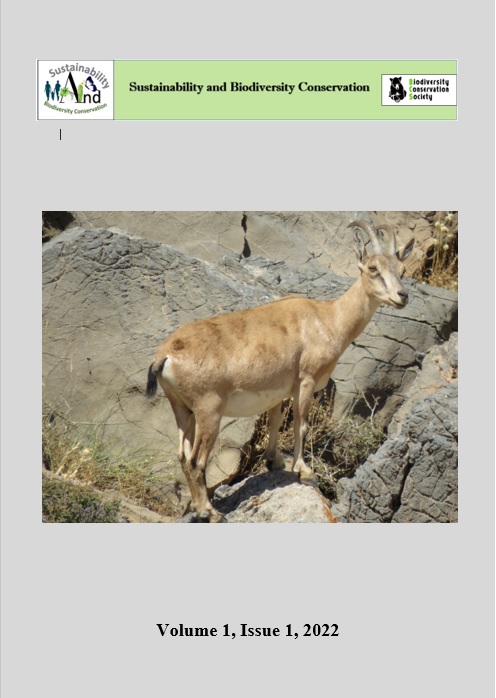Experience of using a Malaise trap to analyze the seasonal activity of some insects
DOI:
https://doi.org/10.5281/zenodo.7135083Keywords:
insects, insect collection methods, seasonal population dynamics, trapsAbstract
Various methods of insect catching are used to monitor seasonal activity. The Malaise trap is not always popular with researchers because it is bulky and difficult to maintain. Seasonal experiments were conducted to analyze the possible use of the Malaise trap in studying the activity of four groups of insects: Orthoptera, Hemiptera (Heteroptera), Mordellidae (Coleoptera), Asilidae (Diptera). From May to October 2021, 914, 101, 662, and 173 individuals were recorded in the Malaise trap, respectively. For all groups, except Hemiptera, the maximum abundance during the season was revealed. The Malaise trap can be successfully used to study the seasonal dynamics of the number of species of different insect groups.
References
Abraham, L., V.Marko, Vas, J. (2003). Investigations on a neuropteroid community by using different methods. Acta Phytopathol. Entomol. Hung. 38: 199–207.
Alexeev, S.C., Aleksanov, V.V. (2017). Pitfall trap construction affects the efficacy of ground beetle counts. Zoologicheskii Zhurnal 96(3): 295–304. DOI: 10.7868/S00 44513417010032
Bomar, C.R. (2001). Comparison of grasshopper (Orthoptera: Acrididae) communities on rem-nant and reconstructed prairies in western Wisconsin. J. Orthoptera Res. 10: 105–112.
Dobony, C.A., Edwards, J.W. (2001). A new flight-interception trap for arthropod sampling. Entomology News. 112: 217-220.
Holguin, G.A., Lehman B.L., Hull L.A., Jones V.P., Jones V.P., Park J., (2010). Electronic traps for automated monitoring of insect populations. IFAC Proceedings Volumes, 43(26): 49-54, https://doi.org/10.3182/20101206-3-JP-3009.00008
Jackman J.A., Nelson, C.R. (1995). Diversity and phenology of tumbling flower beetles (Cole-optera: Mordellidae) captured in a Malaise trap. Entomological News. Vol. 106, № 3. P. 97–107.
Jalas, I. (1960). Eine leichtgebaute, leichttransportable Lichtreuse zum Fangen von Schmetter-lingen. Ann. Entomol. Fenn. 26: 44-50.
Le Cesne, M., S. W.Wilson, Soulier-Perkins A. (2015). Elevational gradient of Hemiptera (Het-eroptera, Auchenorrhyncha) on a tropical mountain in Papua New Guinea. Peerj3: e978.
Martín-Park, A., Delfín-González, H., Sosenski, P., E. Reyes-Novelo, V., Meléndez-Ramírez, J. Navarrete-Carballo, S. Ibáñez-Bernal, F. Dzul-Manzanilla, A. González-Moreno, P. Man-rique-Saide. (2018). Diversity of Tabanidae, Asilidae and Syrphidae (Diptera) in natural protected areas of Yucatan, Mexico. J. Insect Conserv. 22: 85–97.
Mccravy, K.W. (2017). An Analysis of Malaise-Trap Effectiveness in Assessing Robber Fly (Diptera: Asilidae) Species Richness. Northeastern Naturalist 24(1), 15-24. https://doi.org/10.1656/045.024.0102
Mccravy, K.W., Baxa, K.A. (2011). Diversity, Seasonal Activity and Habitat Associations of Robber Flies (Diptera: Asilidae) in West-Central Illinois. American Midland Naturalist 166(1), 85-97. https://doi.org/10.1674/0003-0031-166.1.85
Ohsawa, M. 2010. Beetle families as indicators of Coleopteran diversity in forests: a study us-ing Malaise traps in the central mountainous region of Japan. J. Insect Conserv. 14: 479–484.
Samways, M.J., Moore, S.D. (1991). Influence of exotic conifer patches on grasshopper (Or-thoptera) assemblages in a grassland matrix at a recreational resort, Natal, South Africa. Biol. Conserv. 57: 117–137.
Skvarla, M.J., Larson, J.L., Fisher, J.R., Dowling, A.P.G., (2021). A review of terrestrial and canopy Malaise traps. Annals of the Entomological Society of America, 114(1), 27–47, https://doi.org/10.1093/aesa/saaa044
Taylor, L.R. (1962). The absolute efficiency of insect suction traps. Annals of Applied Biology. 50 (3), 405-421. https://doi.org/10.1111/j.1744-7348.1962.tb06036.x
Downloads
Published
How to Cite
Issue
Section
License
Copyright (c) 2022 Sustainability and Biodiversity Conservation

This work is licensed under a Creative Commons Attribution 4.0 International License.


